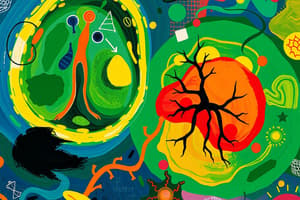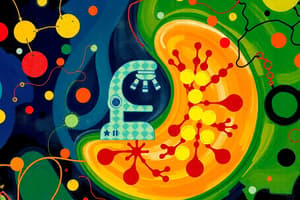Podcast
Questions and Answers
Which organelle is primarily responsible for modifying and packaging proteins for transport within a cell?
Which organelle is primarily responsible for modifying and packaging proteins for transport within a cell?
- Mitochondrion
- Lysosome
- Endoplasmic Reticulum (ER)
- Golgi Apparatus (correct)
According to the cell theory, all cells arise from spontaneous generation.
According to the cell theory, all cells arise from spontaneous generation.
False (B)
Name two pieces of evidence that support the endosymbiotic theory regarding the origin of mitochondria and chloroplasts.
Name two pieces of evidence that support the endosymbiotic theory regarding the origin of mitochondria and chloroplasts.
Mitochondria/chloroplasts have their own DNA, reproduce independently, their ribosomes are similar to bacterial ribosomes.
_____ microscopy is best suited for observing the detailed surface structures of a cell.
_____ microscopy is best suited for observing the detailed surface structures of a cell.
Match the bond type with its description:
Match the bond type with its description:
If a researcher needs to visualize the internal structure of a cell at a very high resolution, which type of microscopy would be most appropriate?
If a researcher needs to visualize the internal structure of a cell at a very high resolution, which type of microscopy would be most appropriate?
Which of the following is NOT a reason why scientists use model organisms in research?
Which of the following is NOT a reason why scientists use model organisms in research?
Which of the following best describes the role of noncovalent interactions in macromolecules?
Which of the following best describes the role of noncovalent interactions in macromolecules?
Which of the following is NOT a primary function of carbohydrates in living organisms?
Which of the following is NOT a primary function of carbohydrates in living organisms?
According to the second law of thermodynamics, the entropy in the universe always decreases.
According to the second law of thermodynamics, the entropy in the universe always decreases.
What is the role of enzymes in biochemical reactions, and how do they achieve this?
What is the role of enzymes in biochemical reactions, and how do they achieve this?
In a redox reaction, the molecule that loses electrons is said to be ________, while the molecule that gains electrons is said to be ________.
In a redox reaction, the molecule that loses electrons is said to be ________, while the molecule that gains electrons is said to be ________.
Match the following biological molecules with their corresponding monomers:
Match the following biological molecules with their corresponding monomers:
Which property of water is most important for capillary action in plants?
Which property of water is most important for capillary action in plants?
What is the significance of Gibbs Free Energy (∆G) in biochemical reactions?
What is the significance of Gibbs Free Energy (∆G) in biochemical reactions?
In the context of enzyme kinetics, what information can be derived from a Lineweaver-Burk plot?
In the context of enzyme kinetics, what information can be derived from a Lineweaver-Burk plot?
Flashcards
Nucleus
Nucleus
Stores DNA and controls gene expression within the cell.
Mitochondria
Mitochondria
The powerhouse of the cell; produces ATP through cellular respiration.
Ribosomes
Ribosomes
Synthesizes proteins; found free-floating or attached to the rough ER.
Golgi Apparatus
Golgi Apparatus
Signup and view all the flashcards
Light Microscopy
Light Microscopy
Signup and view all the flashcards
Electron Microscopy (EM)
Electron Microscopy (EM)
Signup and view all the flashcards
Cell Theory
Cell Theory
Signup and view all the flashcards
Covalent Bonds
Covalent Bonds
Signup and view all the flashcards
Monosaccharides
Monosaccharides
Signup and view all the flashcards
Amino Acids
Amino Acids
Signup and view all the flashcards
Fatty Acids & Glycerol
Fatty Acids & Glycerol
Signup and view all the flashcards
Nucleotides
Nucleotides
Signup and view all the flashcards
1st Law of Thermodynamics
1st Law of Thermodynamics
Signup and view all the flashcards
2nd Law of Thermodynamics
2nd Law of Thermodynamics
Signup and view all the flashcards
Oxidation
Oxidation
Signup and view all the flashcards
Reduction
Reduction
Signup and view all the flashcards
Study Notes
- These are study notes on cell structure, microscopy, biochemistry, thermodynamics, and protein structure and function.
Functional Anatomy of Cellular Organelles
- The nucleus stores DNA and controls gene expression
- Mitochondria perform cellular respiration for ATP production
- Ribosomes synthesize proteins, either free-floating or attached to the rough ER
- The rough ER synthesizes and processes proteins due to ribosomes
- The smooth ER synthesizes lipids and detoxifies substances, lacking ribosomes
- The Golgi apparatus modifies, sorts, and packages proteins
- Lysosomes contain digestive enzymes to break down waste and cellular debris
- Peroxisomes break down fatty acids and neutralize toxins
- The cytoskeleton provides structure and facilitates movement by way of microtubules, actin filaments, and intermediate filaments
Different Types of Microscopy
- Light microscopy uses light and is fit for live cells, but has limited resolution
- Electron microscopy (EM) uses electron beams for higher resolution
- Scanning EM (SEM) provides 3D surface images
- Transmission EM (TEM) provides detailed internal structures
- Fluorescence microscopy utilizes fluorescent dyes to highlight structures in cells
Cell Theory & Endosymbiosis
- The cell theory states that all living things consist of cells, cells are the basic unit of life, and all cells arise from preexisting cells
- Endosymbiosis is the theory that mitochondria and chloroplasts originated from ancient bacteria engulfed by a larger cell, forming a symbiotic relationship
- Mitochondria and chloroplasts have their own DNA
- They reproduce independently within cells
- Their ribosomes are similar to bacterial ribosomes
Importance of Model Organisms
- Model organisms like E. coli, yeast, fruit flies, and mice share similar genes to humans
- Model organisms are easy to grow and study in a lab
- Model organisms help reveal important evolutionary relationships
Chemical Bonding in Biological Molecules
- Covalent bonds are strong bonds where atoms share electrons (e.g., C-H, O-H)
- Ionic bonds form between charged atoms (e.g., NaCl)
- Hydrogen bonds are weak attractions between hydrogen and electronegative atoms, important in water and DNA
- Van der Waals forces are weak interactions between nonpolar molecules
Importance of Noncovalent Interactions in Macromolecules
- Noncovalent interactions help proteins fold into 3D shapes
- Noncovalent interactions stabilize the DNA double helix through hydrogen bonds
- Noncovalent interactions allow enzymes to bind to substrates with specificity
Monomers That Form Macromolecules
- Carbohydrates consist of monosaccharides (glucose) and are used for energy and structure
- Proteins consist of amino acids and form enzymes and structural proteins
- Lipids consist of fatty acids and glycerol, form cell membranes, and store energy
- Nucleic acids consist of nucleotides (A, T, G, C, U) and store genetic information
Importance of Water
- Water's polarity makes it a great solvent
- Hydrogen bonding helps maintain biological structures
- Cohesion and adhesion are important for capillary action in plants
- Heat capacity helps regulate temperature in organisms
Basic Thermodynamic Principles
- The 1st Law of Thermodynamics states energy can only be transformed
- The 2nd Law of Thermodynamics states entropy (disorder) in the universe always increases
- AG (Gibbs Free Energy) determines if a reaction may occur spontaneously
- Negative AG is spontaneous
- Positive AG is non-spontaneous
Oxidation vs. Reduction
- Oxidation is the loss of electrons
- Reduction is the gain of electrons
- During cellular respiration, glucose is oxidized to CO2, and oxygen is reduced to water
Activation Energy & Enzymes
- Activation energy is the energy needed to start a reaction
- Enzymes lower activation energy and speed up reactions without being consumed
Coupled Reactions
- An exergonic reaction (releases energy) can drive an endergonic reaction (requires energy)
- ATP hydrolysis (exergonic) powers muscle contraction (endergonic)
High-Energy Bonds & Activated Carriers
- ATP stores energy in its phosphate bonds
- NADH & NADPH act as electron carriers in metabolic reactions
- NADH is used in cellular respiration; NADPH in photosynthesis
Michaelis-Menten & Lineweaver-Burk Plots
- These plots describe enzyme kinetics
- The Michaelis-Menten curve shows how reaction rate depends on substrate concentration
- The Lineweaver-Burk plot is a double-reciprocal plot used to determine enzyme efficiency
Condensation vs. Hydrolysis
- Condensation joins two molecules, releasing water (e.g., peptide bond formation)
- Hydrolysis breaks a bond with water (e.g., digestion of starch into glucose)
Protein Structures
- Primary (1°) structure is the sequence of amino acids
- Secondary (2°) structure consists of a-helices and B-sheets, held by hydrogen bonds
- Tertiary (3°) structure is a 3D shape due to side chain interactions
- Quaternary (4°) structure is when multiple polypeptide chains interact (e.g., hemoglobin)
Importance of Chaperone Proteins
- Chaperone proteins help proteins fold correctly
- Chaperone proteins prevent misfolding that can cause diseases like prions (mad cow disease)
α-Helix vs. β-Pleated Sheet Proteins
- An a-helix is a coiled structure, for example, keratin in hair
- A B-pleated sheet is a folded structure, for example, silk, collagen, and elastin in connective tissue
- Parallel vs. antiparallel B-sheets determine folding stability
Membrane Protein Folding
- Some proteins fold into structures that fit within the hydrophobic membrane like ion channels
Enzyme Action & Regulation
- Cofactors & coenzymes help enzymes function
- The active site is where the substrate binds
- Allosteric regulation occurs when molecules bind at a site other than the active site to change enzyme activity
- Feedback inhibition is when the end product of a pathway inhibits an earlier enzyme to prevent overproduction
Studying That Suits You
Use AI to generate personalized quizzes and flashcards to suit your learning preferences.
Related Documents
Description
Comprehensive study notes covering cell structure, microscopy types, basic biochemistry, thermodynamics, and protein structure and function. Key topics include the anatomy of cellular organelles and their functions, microscopy techniques, and energy principles governing biological systems.




